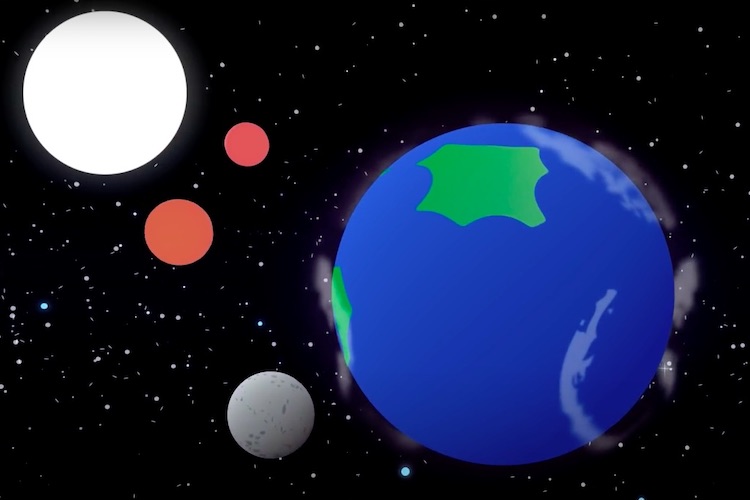The Mathematical Structure of Our Universe
Physicist Max Tegmark on using mathematics to explain the Universe, and how we could develop software to map a...

In August Monthly Notices of the Royal Astronomical Society published an article called “ Connecting the dots II: Phase changes in the climate dynamics of tidally locked terrestrial exoplanets.” We asked one of the authors, Dr. Ludmila Carone from the University of Leuven, to comment on this study.
We investigated with our new versatile climate model, systematically and thoroughly the climate states of rocky planets of Earth and Super-Earth-sizes in the habitable zones of red dwarf stars. We assumed that the planets are tidally locked, that is, that they are always facing their star with the same side.
We found that between orbital periods between 12-100 days, the planet’s circulation system transports heat from the eternal day side towards the night side, allowing for surface liquid water. For orbital periods shorter than 12 days, towards the very inner edge of the habitable zone, the situation becomes more complex. We found that tidally locked planets on very tight orbits can assume first two different climate states (Climate I and II) and for orbital periods shorter than 5 days even three different climate states (Climate I, II and III). We found, furthermore, that two of these states (Climate II and III) allow, in principle, for surface liquid water. Climate I, however, disrupts the transport of heat from the eternal day side towards the night side.
We also found that only the smallest simulated planets on our study with 1 and 1.25 Earth radii sizes show a tendency to assume the habitable climate states II and III for short orbital periods. The largest planets with 1.75 and 2 Earth radii sizes have a stronger tendency to assume very fast equatorial superrotation that disrupts air circulation severely and gives rise to very hot day sides.

Image:The three possible wind systems and temperatures at the surface and in the upper atmosphere for rocky exoplanets of different sizes around red dwarfs. Climate I has a strong eastward wind jet along the equator. Climate II has instead two wind jets at higher latitudes. Climate III has wind jets at higher latitudes and a weak wind jet along the equator. Climate I disturbs the „air conditioning“, which cools the eternal day side. Climate II and III don‘t disturb the „air conditioning“ and are therefore more habitable. (KU Leuven IvS/CmPA/Ludmila Carone).
Habitable zones are defined as the range of planet orbits around a particular star that receives not too much and not too little stellar energy to allow for surface liquid water – assuming the planet has an atmosphere. Red dwarfs are particularly cool and small stars, therefore their habitable zones are relative close-by. In fact, the required distances between the planet and the star are so short that these planets experience extreme tidal forces. One possible consequence may be that these planets are forced into a so called tidal locking scenario, which means that the planet’s rotation rate is synchronized with its revolution rate around the star. At the end, the planet will face its star always with the same side – very much like our Moon faces the Earth always with the same side.
Tidally locked planets were already identified in 1997 by Manoj Joshi and colleagues as potentially habitable due to their air circulation from the day side towards the night side. The authors, however, focused on one Earth radii planet with a relative long orbital period of 16 days. In 2011 Edson already identified one region of possible multiple climate states on tidally locked terrestrial planets for short orbital periods. But they did not characterize the differences between the two states and also did not investigate the possible implications for habitability. They also discussed only planets with the size of one Earth radius.
Super-Earth planets, however, are very common and thus need to be accounted for – as we did in our new study: The space mission Kepler has discovered that 35% of all their discovered exoplanet systems contain rocky planets, many of which are larger than the Earth with sizes of up to two Earth radii.
Yang, on the other hand, showed that even worlds full of water can escape the runaway greenhouse effect relative close to their star – but only if they are tidally locked. In that case, clouds form predominately over the eternal day side. The net effect of the clouds results in a cooling of the atmosphere. In non-tidally locked scenarios, the same clouds lead actually to a net warming of the atmosphere.
New space missions like the Transiting Exoplanet Survey Satellite (TESS, launch in 2017) and the European Planetary Transits and Oscillation of stars (PLATO, launch in 2024) will focus on bright stars in the solar vicinity to find small rocky exoplanets. The chances that many of these candidates will be tidally locked planets around red dwarfs are high: Red dwarfs are the most numerous Sun-like stars. (Sun-like stars are defined as main sequence stars that spend billion years fusing helium and hydrogen together in their core, providing a stable output of stellar energy to allow the formation and evolution of life.) They make up about 70% of all main sequence stars. G main sequence stars like our Sun make up in contrast to that only about 7%. A small rocky planet is also easier to detect around a smaller and less massive star. Furthermore, the closer the orbit of a potentially habitable planet is to its star, the more likely it is that such a planet transits, that is, passes in front of their star from the Earth’s point of view.
Planetary transits open up several avenues to observe the planet’s atmosphere with the upcoming James Webb Space Telescope (launch 2018) and the ground based European Extremely Large Telescope (E-ELT, supposed to start observing in 2024). The shorter the orbital period, the more transits are observed and the more we will learn from the planet’s atmosphere. Climate studies on tidally locked planets around red dwarfs – like our most recent study – will thus guide future observations towards finding the first exoplanet with surface liquid water. Finding water on extrasolar planets is a necessary step towards finding extraterrestrial planets with life in the future.

Physicist Max Tegmark on using mathematics to explain the Universe, and how we could develop software to map a...

Astrophysicist Christopher McKee on the birth of stars, ways to determine the mass of a primordial star, and t...

And which of the names catch on?